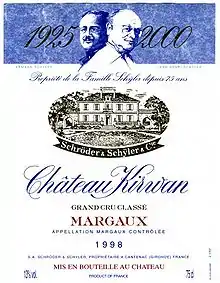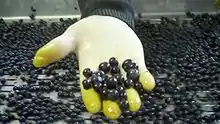Château Kirwan
Das Château Kirwan zählt zu den bekanntesten Weingütern des Médoc in der Weinbauregion Bordeaux. Es liegt in der Gemeinde Cantenac, die zum Bereich der Appellation Margaux im Médoc gehört. Bei der Bordeaux-Klassifizierung im Jahre 1855 erhielt das Gut den dritten Rang (Troisième Cru Classé).


Die Weinberge liegen in unmittelbarer Nachbarschaft zu Château Desmirail und Château Prieuré-Lichine. Die Reben haben ein durchschnittliches Alter von 27 Jahren und sind auf die Rebsorten Cabernet Sauvignon (40 %), Merlot (30 %), Cabernet Franc (20 %) und Petit Verdot (10 %) aufgeteilt. Der Grand Vin reift 18 Monate im Barrique, die jährlich zu einem Drittel erneuert werden.
Der Zweitwein des Gutes heißt Les Charmes de Kirwan.
Geschichte
Der Ursprung geht auf ein Adelsgut Lasalle im 17. Jahrhundert zurück. Anfang des 18. Jahrhunderts wurde es vom britischen Weinhändler John Collingwood gekauft, dessen Tochter den Iren Mark Kirwan ehelichte, der dem Gut im Jahre 1775 den heutigen Namen gab. Anlässlich eines Besuchs in Bordeaux besichtigte der spätere US-Präsident Thomas Jefferson (1743–1826) Château Kirwan (Jefferson beschrieb das Gut unter dem Namen Quirouen) und stufte es in die zweite Kategorie ein.[1] Nach mehreren Besitzerwechseln wurde es im Jahre 1925 von der Firma Schröder und Schÿler gekauft; die Familie Schÿler besitzt noch heute Anteile. Zurzeit wird das Gut von Yann, Natalie und Sophie Schÿler geleitet. Zwischen dem Jahr 1991 und 2001 holte man sich Rat beim renommierten Önologen Michel Rolland und brachte seither umfangreiche Investitionen im Keller auf den Weg. Später engagierte man Jacques Boissenot als begleitenden Önologen.
Literatur
- Charles Cocks, Edouard Féret, Bruno Boidron: Bordeaux et ses vins. 18. Auflage. Èdition Féret et Fils, Bordeaux 2007, ISBN 978-2-35156-013-6.
- Horst Dippel: Das Wein-Lexikon. 3. Auflage. Fischer Taschenbuch Verlag, Frankfurt am Main 1999, ISBN 3-596-13826-4.
- Robert Parker: Parker’s Wein Guide (= Collection Rolf Heyne). Heyne, München 2000, ISBN 3-453-16305-2.
- Nicolas de Rabaudy: Château Kirwan. Histoire d’une renaissance. 1. Auflage. Stock, Paris 1995, ISBN 2-234-04418-9.
Einzelnachweise
- Memoir, Correspondence, And Miscellanies, From The Papers Of Thomas Jefferson, Gutenberg-Projekt
„Of Red wines, there are four vineyards of the first quality; viz. 1. Chateau Margau, belonging to the Marquis d’Agincourt, who makes about one hundred and fifty tons, of one thousand bottles each. He has engaged to Jernon, a merchant. 2. La Tour de Segur, en Saint Lambert, belonging to Monsieur Miresmenil, who makes one hundred and twenty-five tons. 3. Hautbrion, belonging two-thirds to M. le Comte de Femelle, who has engaged to Barton, a merchant: the other third to the Comte de Toulouse, at Toulouse. The whole is seventy-five tons. 4. Chateau de la Fite, belonging to the President Pichard, at Bordeaux, who makes one hundred and seventy-five tons. The wines of the three first, are not in perfection till four years old: those of de la Fite, being somewhat lighter, are good at three years; that is, the crop of 1786 is good in the spring of 1789. These growths, of the year 1783, sell now at two thousand livres the ton; those of 1784, on account of the superior quality of that vintage, sell at twenty-four hundred livres; those of 1785, at eighteen hundred livres; those of 1786, at eighteen hundred livres, though they had sold at first for only fifteen hundred livres. Red wines of the second quality, are Rozan, Dabbadie or Lionville, la Rose, Quirouen, Durfort; in all eight hundred tons, which sell at one thousand livres, new. The third class, are Galons, Mouton, Gassie, Arboete, Pontette, de Ferme, Candale; in all two thousand tons, at eight or nine hundred livres. After these, they are reckoned common wines, and sell from five hundred livres, down to one hundred and twenty livres, the ton. All red wines decline after a certain age, losing color, flavor, and body. Those of Bordeaux begin to decline at about seven years old.“
– Thomas Jefferson